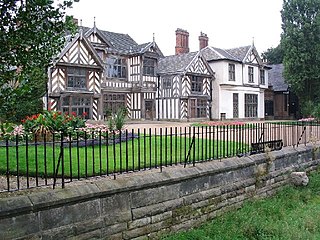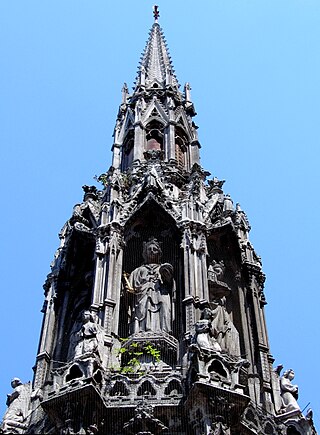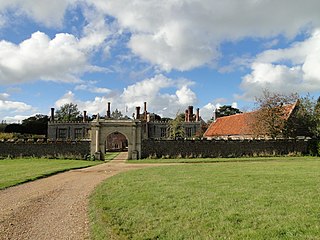
Wythenshawe Hall is a 16th-century timber-framed historic house and former manor house in Wythenshawe, Manchester, England, five miles (8 km) south of Manchester city centre in Wythenshawe Park. Built for Robert Tatton, it was home to the Tatton family for almost 400 years. Its basic plan is a central hall with two projecting wings.

Harlaxton Manor is a Victorian country house in Harlaxton, Lincolnshire, England. It was built for Gregory Gregory, a local squire and businessman. Gregory employed two of the leading architects of Victorian England, Anthony Salvin and William Burn and consulted a third, Edward Blore, during its construction. Its architecture, which combines elements of Jacobean and Elizabethan styles with Baroque decoration, makes it unique among England's Jacobethan houses. Harlaxton is a Grade I listed building on the National Heritage List for England, and many other structures on the estate are also listed. The surrounding park and gardens are listed Grade II* on the Register of Historic Parks and Gardens. It is now the British campus of the University of Evansville.

Cragside is a Victorian Tudor Revival country house near the town of Rothbury in Northumberland, England. It was the home of William Armstrong, 1st Baron Armstrong, founder of the Armstrong Whitworth armaments firm. An industrial magnate, scientist, philanthropist and inventor of the hydraulic crane and the Armstrong gun, Armstrong also displayed his inventiveness in the domestic sphere, making Cragside the first house in the world to be lit using hydroelectric power. The estate was technologically advanced; the architect of the house, Richard Norman Shaw, wrote that it was equipped with "wonderful hydraulic machines that do all sorts of things". In the grounds, Armstrong built dams and lakes to power a sawmill, a water-powered laundry, early versions of a dishwasher and a dumb waiter, a hydraulic lift and a hydroelectric rotisserie. In 1887, Armstrong was raised to the peerage, the first engineer or scientist to be ennobled, and became Baron Armstrong of Cragside.

Eaton Hall is the country house of the Duke of Westminster. It is 1 mile (2 km) south of the village of Eccleston, in Cheshire, England. The house is surrounded by its own formal gardens, parkland, farmland and woodland. The estate covers about 10,872 acres (4,400 ha).

Edward Blore was a 19th-century English landscape and architectural artist, architect and antiquary.
Samuel Sanders Teulon was an English Gothic Revival architect, noted for his use of polychrome brickwork and the complex planning of his buildings.
Charles Buxton was an English brewer, philanthropist, writer and member of Parliament.

Crewe Hall is a Jacobean mansion located near Crewe Green, east of Crewe, in Cheshire, England. Described by Nikolaus Pevsner as one of the two finest Jacobean houses in Cheshire, it is listed at grade I. Built in 1615–36 for Sir Randolph Crewe, it was one of the county's largest houses in the 17th century, and was said to have "brought London into Cheshire".

Old Buckenham Hall School is a day and boarding preparatory school with pre-prep for boys and girls in the village of Brettenham, Suffolk, England.

Sir John Jacob Buxton, 2nd Baronet was a politician from Shadwell Court in Brettenham, Norfolk who sat in the House of Commons from 1818 to 1832.

Bredon School, formerly Pull Court, is a private school in Bushley, Worcestershire, England. The house was built for the Reverend Canon E. C. Dowdeswell by Edward Blore between 1831 and 1839. The site is much older and Blore's house replaced an earlier mansion. The Dowdeswells had been prominent in local and national politics since the 18th century, with many serving as members of Parliament. The family sold the house in 1934 to the parents of Richard Seaman, a prominent pre-war racing driver, who lived there until his death in a crash in the 1939 Belgian Grand Prix. In 1962, the court became a school, Bredon School, founded by Lt-Col Tony Sharp and Hugh Jarrett, for the education of boys who had failed the Common Entrance Examination. It remains a specialist school with a focus on educating children with specific learning difficulties, such as dyslexia and dyspraxia.

Thomas Earp (1828–1893) was a British sculptor and architectural carver who was active in the late 19th century. His best known work is his 1863 reproduction of the Eleanor Cross which stands at Charing Cross in London. He specialised in sculpture for Gothic Revival churches and worked closely with the architect George Edmund Street in the 1860s and 1870s.
William Milford Teulon was an English architect and landscape designer.

Merton Hall is a 19th century country house in Merton, Norfolk, England. The extant north-west wing is a Grade II listed building. The 17th-century gatehouse, the 19th century stables and other associated buildings are also listed. The house stands in a park about 2 miles in length.

Elvetham Hall is a hotel in Hampshire, England, in the parish of Hartley Wintney about 2 miles (3 km) northwest of Fleet. The building is a High Victorian Gothic Revival English country house and a Grade II* listed building. It stands in a landscaped park that is Grade II listed.

Bearwood or Bear Wood, Sindlesham, Berkshire, England is a Victorian country house built for John Walter, the owner of The Times. The architect was Robert Kerr and the house was constructed between 1865 and 1874. The family fortune had been made by Walter's grandfather, John Walter I. Originally a coal merchant and underwriter, in 1785 John Walter had established The Daily Universal Register, renamed as The Times in 1788. In 1816, Walter's father, John Walter II purchased the Bear Wood estate in Berkshire from the Crown Estate and in 1822 built a small villa on the site of the present house. Nothing remains of this first building, which was swept away in the gargantuan rebuilding undertaken by Kerr for John Walter III. The cost, £129,000, equivalent to £12,741,576 in 2021, was double the original estimate.

Lechlade Manor in Lechlade, Gloucestershire, England, is a Victorian country house built for George Milward, a lawyer, by John Loughborough Pearson. Primarily an ecclesiastical architect, working on over 200 church buildings in his fifty-year career, the manor represents one of Pearson's rare forays into secular building. Dating from 1872 to 1873, Lechlade was subsequently sold to the Sisters of St Clotilde and operated as a convent for much of the 20th century. In the 1990s, it was converted back to a private residence, with some enabling development in the grounds. Lechlade Manor is a Grade II listed building.

Hunstanton Hall, Old Hunstanton, Norfolk, England is a country house dating originally from the 15th century. The gatehouse, now detached from the main building, is dated 1487. The wings were built in the seventeenth century and there are Victorian additions. The house was the ancestral home of the L'Estrange family, resident from the time of Domesday until after World War II. During the early 20th century, P. G. Wodehouse, a friend of Charles Le Strange, was a frequent visitor and the hall features in his novel Money for Nothing (1928) and his collection of short stories Very Good, Jeeves (1930). The hall has also been suggested as a model for Blandings Castle. The building suffered two major fires, in 1853 and 1947. In 1948, the hall was sold and converted into apartments. Hunstanton Hall is a Grade I listed building.

Woodlands Vale is a Victorian era house in Seaview on the Isle of Wight. It is a Grade II* listed building.

















